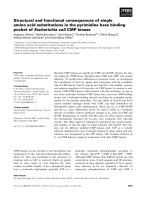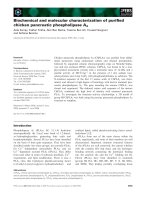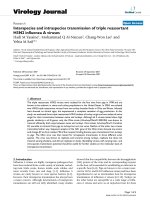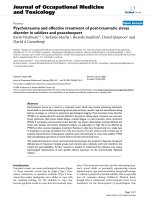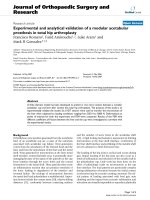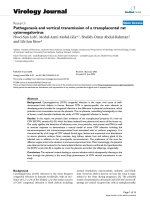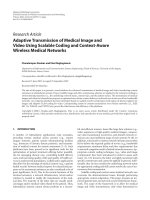Báo cáo thú y: "Direct and indirect transmission of four Salmonella enterica serotypes in pigs" docx
Bạn đang xem bản rút gọn của tài liệu. Xem và tải ngay bản đầy đủ của tài liệu tại đây (500.12 KB, 7 trang )
Österberg et al. Acta Veterinaria Scandinavica 2010, 52:30
/>Open Access
RESEARCH
BioMed Central
© 2010 Österberg et al; licensee BioMed Central Ltd. This is an Open Access article distributed under the terms of the Creative Commons
Attribution License ( which permits unrestricted use, distribution, and reproduction in
any medium, provided the original work is properly cited.
Research
Direct and indirect transmission of four
Salmonella
enterica
serotypes in pigs
Julia Österberg*
1,2
, Susanna Sternberg Lewerin
1
and Per Wallgren
1,2
Abstract
Background: Feed-borne spread of Salmonella spp. to pigs has been documented several times in recent years in
Sweden. Experiences from the field suggest that feed-associated serotypes might be less transmittable and
subsequently easier to eradicate from pig herds than other serotypes more commonly associated to pigs. Four
Salmonella serotypes were selected for experimental studies in pigs in order to study transmissibility and compare
possible differences between feed-assoociated (S Cubana and S Yoruba) and pig-associated serotypes (S Derby and S
Typhimurium).
Methods: Direct contact transmission was studied in four groups of pigs formed by six 10-week-old salmonella
negative pigs commingled with two fatteners excreting one of the four salmonella serotypes. Indirect transmission was
studied by putting six 10-week-old salmonella negative pigs in each of four salmonella contaminated rooms. Each
room had previously housed a group of pigs, excreting one of the four selected serotypes.
All pigs were monitored for two weeks with respect to the faecal excretion of salmonella and the presence of serum
antibodies. At the end of the trial, eight samples from inner tissues and organs were collected from each pig at
necropsy.
Results: In the four direct transmission groups, one pig shed Salmonella (Cubana) at one occasion. At necropsy, S
Typhimurium was isolated from one pig.
In the indirect transmission groups, two pigs in the Yoruba room and one pig in each of the other rooms were
excreting detectable levels of Salmonella once during the study period of two weeks. At necropsy, S Derby was
isolated from one of six pigs in the Derby room and S Typhimurium was isolated from four of the six pigs in the
Typhimurium room.
No significant serological response could be detected in any of the 48 pigs.
Conclusions: These results show that all four selected serotypes were able to be transmitted in at least one of these
field-like trials, but the transmission rate was low in all groups and no obvious differences between feed-associated and
pig-associated serotypes in the transmission to naïve pigs and their subsequent faecal shedding were revealed.
However, the post mortem results indicated a higher detection of S Typhimurium in the ileocecal lymph nodes of pigs
introduced into a contaminated environment in comparison with the other three serotypes.
Background
All serotypes of Salmonella are considered a potential
health hazard to humans [1,2]. The serotypes commonly
detected in raw feed materials in Sweden often differ
from the serotypes most often isolated from animals and
humans. However, in recent years some of these "feed-
associated" serotypes have been detected in pig herds [3-
5]. Changes in the feed industry, with a higher proportion
of imported raw feed materials with a higher prevalence
of Salmonella spp. [6], might be an explanation for this
detection of "new" serotypes in Swedish pig herds.
Why only few of the "feed-associated" serotypes seem
to reach and/or spread within the animal population has
not been sufficiently investigated, although consequent
monitoring of imported raw feed materials for presence
of Salmonella, with subsequent heat- and acid treatments
* Correspondence:
1
National Veterinary Institute, SVA, SE-751 89 Uppsala, Sweden
Full list of author information is available at the end of the article
Österberg et al. Acta Veterinaria Scandinavica 2010, 52:30
/>Page 2 of 7
whenever detected, certainly contribute to this. Most
serotypes detected in raw feed materials or in feed plants
have not been studied in animals under experimental
conditions. The transmission of Salmonella in pigs seems
to be serovar related [7]. Also, experiences from the field
suggest that some serotypes are more transient in the pig
than others. However, if this is a matter of virulence fac-
tors, dose-response characteristics or due to other epide-
miological differences are not fully known.
According to the Swedish law, action must be taken to
eliminate the infection or contamination with Salmonella
spp. whenever the bacterium is detected in the food chain
of animal products (Zonoosis Act, SFS 1999:658). This
means that when Salmonella spp. is detected in a herd,
the herd is put under restrictions prohibiting animals to
leave the farm before all infected animals have been
culled or tested negative in two feacal samples taken one
month apart. Furthermore, all contaminated surfaces on
the premises must be thoroughly cleaned and disinfected
before the restrictions can be lifted. With increasing herd
sizes in modern agriculture the costs for the control of
Salmonella at herd level are increasing, emphasizing the
need for more cost-efficient eradication measures.
In previous studies we have compared the two feed-
associated serotypes S Yor uba and S Cubana with the two
"classic" serotypes S Typhimurium and S Derby, as
regards infectious dose, faecal excretion pattern, antibody
response and distribution in internal organs and tissues
[8,9] with the aim to elucidate possible differences
between serotypes that might be of significance for Sal-
monella control strategies.
In the present study we continued the comparative
examinations of these four selected serotypes by studying
their ability to infect pigs through direct and indirect
transmission, intending to resemble the conditions pres-
ent in pig herds. The specific aim of these experiments
was to investigate if the results obtained would support
the idea of adapting herd level eradication strategies to
different serotypes of Salmonella.
Methods
Animals and experimental facilities
Pigs (Yorkshire x Swedish Landrace) aged 10 weeks were
bought from a Swedish nucleus herd, with a well docu-
mented high health status. The herd was regularly moni-
tored for Salmonella spp. by bacteriological analysis of
faecal samples. The herd was also declared free from
atrophic rhinitis, mange, swine dysentery and PMWS by
domestic control programs. Furthermore, Sweden is free
from PRRS and Aujeszky's disease.
On two occasions, 24 pigs, originally derived from six
litters, were transported to the research facilities at the
National Veterinary Institute (NVI) in Uppsala and split
into four groups on arrival, each group including one pig
from each of the six litters.
Each group was housed in a pen in a separate room, as
previously described in detail [8]. The rooms were sepa-
rated also with respect to the ventilation and the manure
systems. The pen in each room had a solid concrete floor
with sawdust bedding covering half of the pen. The dung
was cleared out twice daily. The pigs were fed a pelleted
fattening feed (Origo 522 PK; Lantmännen, Svalöv, Swe-
den).
Experimental design
The experiments were approved by the ethical committee
for animal experiences in Uppsala, Sweden (licence C264/
5).
Direct contact transmission (DT) was studied by mixing
six pigs with two seeder pigs, aged 18 weeks, originally
from the same herd as the younger pigs, in each of four
cleaned and disinfected pens (in total 24 naïve pigs and
eight seeder pigs). The two seeder pigs in each group had
a well documented history of long-term feacal excretion
of one of the four serotypes of Salmonella, as they had
been part of another study and inoculated with 10
9
colony
forming units (CFU) of the serotype eight weeks earlier
[8,9].
Indirect transmission (IT) was studied in six pigs in
each of four pens (in total 24 naïve pigs), where Salmo-
nella infected pigs had previously been housed as part of
another study. In that former study, six pigs in each pen
had been inoculated with 10
9
CFU of one of the four sero-
types studied and their faecal excretion of Salmonella had
been monitored for eight weeks [8,9]. The inoculated pigs
left the pens the same morning as the new, uninfected
pigs were introduced to the same, scraped but not
washed, pens.
In both the direct and the indirect transmission study,
the pigs were monitored for two weeks, with respect to
the excretion of Salmonella in faeces and the presence of
antibodies in serum. Further sampling to demonstrate
presence of Salmonella was carried out at necropsy at the
end of the trial.
Collection of samples
Individual faecal samples were collected on arrival to the
experimental facilities at the NVI, prior to the commin-
gling with the seeder pigs or the introduction to the con-
taminated pens, respectively (Day 0). Thereafter, faecal
samples were collected daily for four days (Day 1, 2, 3 and
4) and four times during the second week (Day 7, 9, 11
and 14).
Blood samples were collected into plain tubes from all
pigs on Day 0, 7 and 14. The serum was removed and
stored at -20°C until analysed.
Österberg et al. Acta Veterinaria Scandinavica 2010, 52:30
/>Page 3 of 7
All pigs were euthanised and necropsied on Day 14. At
necropsy, tissue samples were collected from each pig
from the following eight sites; tonsil, liver, spleen, colonic
tissue, caecum contents and three lymph nodes (the man-
dibular, ileocecal and colonic lymph nodes).
Qualitative culture of Salmonella species
Qualitative analyses were initiated within a couple of
hours after the collection of faecal samples, using modi-
fied semi-solid Rappaport Vassiliadis (MSRV) selective
enrichment medium (Draft Amendment ISO 6579:
2002).
The organ samples were cut with a scalpel into small
pieces, before they were pre-enriched in a 1:9 dilution of
BPW (CM0509; Oxoid) and further analysed in the same
way as the faecal samples. The confirmation of the sero-
types was made by direct agglutination, as previously
described [8].
Detection of serum antibodies
Serum antibodies to S Typhimurium were detected with a
commercial ELISA (Svanovir; Svanova Biotech). Anti-
bodies to S Yoruba were analysed with an in-house ELISA
[8].
Serum antibodies to the two serotypes S Cubana and S
Derby were analysed with a commercial ELISA (Herd-
chek Swine Salmonella, IDEXX Laboratories) based on
LPS-antigens from Salmonella serogroups B, C1 and D.
Results
Direct contact transmission (DT)
In all four DT groups, Salmonella was isolated from at
least one of the two seeder pigs in at least one faecal sam-
ple collected during the study period of two weeks (Fig-
ure 1). Taken together, seven of the eight seeder pigs were
Salmonella positive in 14 of the totally 64 samples col-
lected. Except for one weaner shedding S Cubana on day
7, the younger pigs were all Salmonella negative in faeces
during the entire period studied (Figure 1).
All pigs were seronegative to Salmonella prior to the
study. In the DT trials with S Typhimurium, S Derby and
S Cubana all pigs remained serologically negative.
The in-house ELISA constructed to detect antibodies
against S Yoruba resulted in two pigs with an antibody
level just above the cut-off at A
450
= 0.60 (the highest
reaction being 0.72).
The results from the culture of the post mortem sam-
ples are shown in Figure 1. Four of the eight seeder pigs
had at least one post mortem sample from which the
expected serotype of Salmonella was isolated. One
weaner in the DT Typhimurium group was positive for S
Typhimurium in the caecum content. All other samples
from the 24 naive pigs in the DT study were Salmonella
negative (n = 191) (Figure 1).
All the Salmonella positive cultures were confirmed by
direct agglutination and in each sample the expected
serotype was isolated.
Indirect contact transmission (IT)
Two pigs located in the pen contaminated with S Yoruba
shed S Yoruba once during the experimental period of
two weeks (Figure 2). In each of the other three groups (in
pens contaminated with S Typhimurium, S Cubana and S
Derby, respectively) Salmonella was detected in faeces
from one pig on one occasion.
All pigs were seronegative to Salmonella when entering
the contaminated facilities. All pigs that had been housed
in pens contaminated with S Typhimurium, S Derby or S
Cubana remained serologically negative throughout the
study. The in-house ELISA resulted in two pigs in the
Yoruba room with serological reactions just above the
cut-off at A
450
= 0.60 (the highest reaction being 0.82).
S Typhimurium was demonstrated in at least one post
mortem sample from four of the six pigs in the S Typh-
imurium contaminated pen. Three of these four pigs had
S Typhimurium isolated from the ileocecal lymph node.
One pig in the S Derby contaminated pen was positive for
S Derby in three of the eight samples collected at
necropsy, while the other pigs in that group as well as all
pigs from the S Cubana and S Yorub a contaminated
rooms were all Salmonella negative in the post mortem
samples (Figure 2).
All the Salmonella positive bacteriological samples
were confirmed by direct agglutination and in each sam-
ple the expected serotype was isolated.
Discussion
Salmonella appeared not to be readily transmitted to the
naive pigs in these trials, neither from the seeder pigs, nor
from the contaminated pens. Nevertheless, Salmonella
was transmitted to at least one pig in all groups except in
two of the direct contact groups (DT-trial; S Yoruba and S
Derby). The division into a direct and an indirect trans-
mission was made to mirror two different field situations,
both expected to be of importance in an infected herd.
The pathogen load appeared to be higher in the contami-
nated pens than from the intermittently shedding seeder
pigs at a late stage of infection. However, the rate of trans-
mission was low in both the direct and the indirect trans-
mission situation and no differences between the four
serotypes could be concluded with respect to the faecal
shedding of Salmonella. These trials were performed in
facilities with a high level of biosecurity, allowing only a
limited number of pigs. This reduced the possibility to
detect small differences between serotypes, but the
design of the study was still regarded to be sufficient for
its purpose.
Österberg et al. Acta Veterinaria Scandinavica 2010, 52:30
/>Page 4 of 7
Figure 1 The individual faecal shed of Salmonella in pigs following mixing of two seeder pigs with six naive pigs (DT-study). The two seeder
pigs in each group were inoculated with 0.65 × 10
9
cfu of one of four different serovars of Salmonella eight weeks earlier. Demonstration of Salmonella
is illustrated by white, whereas grey illustrates that Salmonella was not detected. In the right column the results from analysis of Salmonella in tissue
samples taken post mortem are shown. Within brackets the tissue from which Salmonella was isolated are abbreviated as follows: cecum content =
cec, colon lymph node = col, colon tissue = cot, tonsil = ton.
Day 1 2 3 4 7 9 11 14
Post mortem
Yoruba Pig
1
Neg. Neg. Neg. Neg. Neg. Neg. Neg. Neg.
All neg.
2
Neg. Neg. Neg. Neg. Neg. Neg. Neg. Neg.
All neg.
3
Neg. Neg. Neg. Neg. Neg. Neg. Neg. Neg.
All neg.
4
Neg. Neg. Neg. Neg. Neg. Neg. Neg. Neg.
All neg.
5
Neg. Neg. Neg. Neg. Neg. Neg. Neg. Neg.
All neg.
6
Neg. Neg. Neg. Neg. Neg. Neg. Neg. Neg.
All neg.
Seeder pig 1 Neg. Neg.
Pos.
Neg. Neg. Neg. Neg. Neg.
All neg.
Seeder pig 2 Neg. Neg. Neg.
Pos.
Neg. Neg. Neg. Neg.
Pos.(tons,coll)
Typhim. Pig
1
Neg. Neg. Neg. Neg. Neg. Neg. Neg. Neg.
Pos.(cecc)
2
Neg. Neg. Neg. Neg. Neg. Neg. Neg. Neg.
All neg.
3
Neg. Neg. Neg. Neg. Neg. Neg. Neg. Neg.
All neg.
4
Neg. Neg. Neg. Neg. Neg. Neg. Neg. Neg.
All neg.
5
Neg. Neg. Neg. Neg. Neg. Neg. Neg. Neg.
All neg.
6
Neg. Neg. Neg. Neg. Neg. Neg. Neg. Neg.
All neg.
Seeder pig 1 Neg.
Pos.
Neg. Neg.
Pos.
Neg. Neg. Neg.
Pos.(tons)
Seeder pig 2 Neg. Neg. Neg. Neg. Neg. Neg. Neg. Neg.
All neg.
Cubana
Pig
1
Neg. Neg. Neg. Neg. Neg. Neg. Neg. Neg.
All neg.
2
Neg. Neg. Neg. Neg. Neg. Neg. Neg. Neg.
All neg.
3
Neg. Neg. Neg. Neg. Neg. Neg. Neg. Neg.
All neg.
4
Neg. Neg. Neg. Neg.
Pos.
Neg. Neg. Neg.
All neg.
5
Neg. Neg. Neg. Neg. Neg. Neg. Neg. Neg.
All neg.
6
Neg. Neg. Neg. Neg. Neg. Neg. Neg. Neg.
All neg.
Seeder pig 1
Pos.
Neg. Neg.
Pos. Pos. Pos.
Neg.
Pos. Pos.(colt, cecc)
Seeder pig 2
Pos.
Neg. Neg. Neg. Neg. Neg. Neg. Neg.
Pos.(cecc)
Derby
Pig
1
Neg. Neg. Neg. Neg. Neg. Neg. Neg.
Neg. All neg.
2
Neg. Neg. Neg. Neg. Neg. Neg. Neg. Neg.
All neg.
3
Neg. Neg. Neg. Neg. Neg. Neg. Neg. Neg.
All neg.
4
Neg. Neg. Neg. Neg. Neg. Neg. Neg. Neg.
All neg.
5
Neg. Neg. Neg. Neg. Neg. Neg. Neg. Neg.
All neg.
6
Neg. Neg. Neg. Neg. Neg. Neg. Neg. Neg.
All neg.
Seeder pig 1 Neg. Neg. Neg.
Pos.
Neg.
Pos. Pos.
Neg.
All neg.
Seeder pig 2 Neg. Neg. Neg.
Pos.
Neg. Neg. Neg. Neg.
All neg.
Österberg et al. Acta Veterinaria Scandinavica 2010, 52:30
/>Page 5 of 7
Still, a difference between serotypes was indicated by
the results obtained post-mortem as S Typhimurium was
re-isolated from the majority of the pigs that had been
housed in the contaminated environment. The most
common site for the detection of S Typhimurium was the
ileocecal lymph node. In concordance with our results,
eight of nine pigs in another study were positive for S
Typhimurium in the ileocolic lymph node three weeks
after mixing with inoculated, Salmonella-shedding pigs,
although most of the pigs were negative in rectal swabs
collected during the trial period of three weeks [10]. Sev-
eral other studies have also shown the affinity for the ileo-
cecal/ileocolic lymph nodes of S Typhimurium [11-13].
Conversely, the feed-associated serotypes S Yoruba and S
Cubana were not demonstrated in any lymphatic or other,
non-intestinal, tissues, well in accordance with our previ-
ous results [8,9].
A number of studies have shown a rapid transmission
of Salmonella spp. to pigs put in a contaminated environ-
ment [14-17]. These studies have mainly focused on the
Figure 2 The individual faecal shed of Salmonella in six pigs after their introduction into Salmonella contaminated pens (IT-study). The pens
had harboured Salmonella shedding pigs, individually inoculated with 0.65 × 10
9
cfu of Salmonella eight weeks earlier. The inoculated pigs were re-
moved and replaced with the naive, 10 weeks old pigs. Demonstration of Salmonella is illustrated by white, whereas grey illustrates that Salmonella
was not detected. In the right column the results from analysis of Salmonella in tissue samples taken after euthanisation are shown. Within brackets
the tissue from which Salmonella were isolated are abbreviated as follows: cecum content = cec, colon tissue = cot, ileocecal lymph node = iln.
Day 1 2 3 4 7 9 11 14
Postmortem
Yoruba Pig
1
Neg. Neg. Neg. Neg. Neg. Neg. Neg. Neg.
All neg.
2
Neg. Neg. Neg. Neg. Neg. Neg. Neg. Neg.
All neg.
3
Neg. Neg. Neg. Neg. Neg.
Pos.
Neg. Neg.
All neg.
4
Neg. Neg. Neg. Neg. Neg.
Pos.
Neg. Neg.
All neg.
5
Neg. Neg. Neg. Neg. Neg. Neg. Neg. Neg.
All neg.
6
Neg. Neg. Neg. Neg. Neg. Neg. Neg. Neg.
All neg.
Typhim. Pig
1
Neg. Neg. Neg. Neg. Neg. Neg. Neg. Neg.
Pos. (illn)
2
Neg. Neg. Neg. Neg. Neg. Neg. Pos. Neg. Pos.(illn,cecc)
3
Neg. Neg. Neg. Neg. Neg. Neg. Neg. Neg. Pos.(cecc)
4
Neg. Neg. Neg. Neg. Neg. Neg. Neg. Neg. Allneg.
5
Neg. Neg. Neg. Neg. Neg. Neg. Neg. Neg. Pos.(illn)
6
Neg. Neg. Neg. Neg. Neg. Neg. Neg. Neg. Allneg.
Cubana
Pig
1
Neg. Neg. Neg. Neg. Neg. Neg. Neg. Neg.
All neg.
2
Neg. Neg. Neg. Neg. Neg. Neg. Neg. Neg.
All neg.
3
Neg. Neg. Neg. Neg. Neg. Neg. Neg. Neg.
All neg.
4
Neg. Neg. Neg. Neg. Neg. Neg. Neg. Neg.
All neg.
5
Neg. Neg. Neg. Neg. Neg. Neg. Neg. Neg.
All neg.
6
Pos. Neg. Neg. Neg. Neg. Neg. Neg. Neg.
All neg.
Derby
Pig
1
Neg. Neg. Neg. Neg. Neg. Neg. Neg.
Pos.
Pos.(illn,colt,cecc)
2
Neg. Neg. Neg. Neg. Neg. Neg. Neg. Neg.
All neg.
3
Neg. Neg. Neg. Neg. Neg. Neg. Neg. Neg.
All neg.
4
Neg. Neg. Neg. Neg. Neg. Neg. Neg. Neg.
All neg.
5
Neg. Neg. Neg. Neg. Neg. Neg. Neg. Neg.
All neg.
6
Neg. Neg. Neg. Neg. Neg. Neg. Neg. Neg.
All neg.
Österberg et al. Acta Veterinaria Scandinavica 2010, 52:30
/>Page 6 of 7
transmission of Salmonella occurring at transport and in
lairage at abattoirs. The time frame of interest was then
counted in hours, but the situation for the pigs was
crowded and stressful which raises the risk for spread of
the infection [18,19]. Our study aimed to resemble the
situation at herd level to investigate the risk for transmis-
sion to naive pigs when exposed to contaminated pens or
to infected pen mates. Thus, the density of pigs and the
stress level were lower, which may have contributed to
the low rate of Salmonella transmission despite the fairly
long exposure period. Yet, it can not be ruled out that a
longer study period than two weeks would have led to a
more thorough transmission of the pathogen.
Above all, the contamination level in the environment
is probably the most important factor affecting the spread
of Salmonella in a pen. A difference in infection rate of
pigs following exposure to pens contaminated with differ-
ent levels of S Typhimurium has been reported [14]. Still,
no attempt to quantify the contamination level of the
pens was performed in the present study, due to an
expected uneven distribution of Salmonella in the con-
taminated pens with a subsequent difficulty to define the
true pathogen load. However, the shedding of Salmonella
had been considerable in the pigs that had been housed in
the pens in the previous trials [8,9]. This ought to have
guaranteed a thorough contamination of the pens for the
study of indirect transmission, especially since they were
not washed before the introduction of naive pigs. Further,
the water nipple in each pen was placed in the corner
used as dunging area and the naive pigs drank from the
floor until they had learnt to use the nipple properly. The
one pig shedding S Cubana the second day in the pen was
probably a result of such drinking.
In the DT-study, a majority of the seeder pigs showed
signs of reduced shedding as eight weeks had passed
since the inoculation of 10
9
CFU [8,9]. Also in this trial no
attempts to estimate the challenge dose were performed.
The qualitative analysis was regarded good enough, as
our main interest was to measure if the numbers of bacte-
ria were enough to reach above the threshold for detect-
able infection. Also, to quantify the concentration of
Salmonella in the faeces of the seeder pigs was deemed
not very useful as it is variable and the dose also would
have been affected by the build-up of environmental con-
tamination. As the direct transmission was studied in
previously cleaned and disinfected facilities the pathogen
load was probably low. However, one of the S Cubana
seeder pigs had a history of constant faecal shedding in all
the 23 faecal samples collected during the eight weeks
prior to the commingling with the naive pigs [9] and con-
tinued to shed S Cubana in five of the eight faecal samples
collected during the study period of two weeks. This was
also the only group where faecal shedding of Salmonella
was demonstrated in the weaners in the DT-study. Thus,
it would appear that a pig shedding Salmonella in faeces,
at a detectable but low level does not necessarily transmit
the pathogen to its pen-mates, even in a solid floor envi-
ronment.
Several studies show that factors such as poor pen
cleaning, stress, concurrent disease, overcrowding and
different feeding regimes are important for the infection
dynamics in a herd [18-21]. In addition, the rate of trans-
mission of Salmonella in a herd may be serotype-related.
The pig-adapted serotype S Derby, for example, has man-
aged to survive in a pig herd for more than a decade, in
spite of several eradication attempts [22]. In contrast,
only very few reoccurrences of Salmonella were demon-
strated after the initial diagnosis of S Cubana in faeces in
31 farms, following a feed-borne spread of S Cubana in
2003 [4]. In the present study, the culture results from the
necropsy of the IT-Typhimurium group (with four out of
six pigs being positive for S Typhimurium) may have mir-
rored a higher pathogen load in this room, but more
probably reflected that this serotype differs from the
other three serotypes in a low-contaminated environ-
ment.
In conclusion, the low level of transmission of all four
serotypes in both trials most likely reflected an overall
low dose exposure and mirrored the dose-response rela-
tionship that has been shown in previous studies [8,9,23].
Therefore, these results high-lights the importance of
hygienic measures rather than indicate a possibility for
the adaptation of control strategies to different serotypes.
A thorough cleaning and disinfection of units between
batches of pigs can reduce the contamination level of the
pen below the infection threshold, which may prevent the
transmission of Salmonella spp. to the subsequent batch
of pigs. This could be an important step to decrease the
prevalence at slaughter, provided that the pigs are not
infected/contaminated at a later stage, i.e. during trans-
port, lairage or slaughter. Thus, hygienic measures in
order to reduce the level of contamination in the environ-
ment in all stages of the animal-food chain still constitute
the basis for the control of Salmonella spp.
Conclusions
The present study showed a transmission of all four
selected serotypes to the naive pigs in the contaminated
environment and for two of the serotypes (S Cubana and
S Typhimurium) in the direct contact situation. However,
it did not indicate any obvious differences between them
in their transmissibility, but rather showed a low trans-
mission for all four serotypes studied. Neither did pigs
that shed Salmonella necessarily transmit the pathogen
to its pen-mates, nor did a Salmonella-contaminated
environment inevitably lead to infected pigs.
These results high lights the importance of high
hygienic standards in the environment of the pigs, in
Österberg et al. Acta Veterinaria Scandinavica 2010, 52:30
/>Page 7 of 7
order to reduce the risk for high numbers of Salmonella
to accumulate in the surroundings of the pigs. Neverthe-
less, in contrast to the other serotypes S Typhimurium
was re-isolated from the ileocecal lymph nodes of three
out of six pigs at necropsy, indicating a difference in the
ability to infect a pig in a low-contaminated environment.
Competing interests
The authors declare that they have no competing interests.
Authors' contributions
JÖ was the co-ordinator involved in all parts of the study. JÖ also performed
the collection of samples, participated in the laboratory work and was the
main author of the manuscript. PW and SSL contributed to the design and
planning and made substantial contributions in revising the manuscript criti-
cally. All authors have read and approved the final manuscript.
Acknowledgements
The authors thank Sigbrit Mattson and Maria Persson for skilful assistance in
the laboratory and Per Karlsson for taking good care of the pigs. The work was
financed by the National Veterinary Institute (SVA) in Sweden.
Author Details
1
National Veterinary Institute, SVA, SE-751 89 Uppsala, Sweden and
2
Department of Clinical Sciences, Swedish University of Agricultural Sciences,
SE-750 07 Uppsala, Sweden
References
1. Anonymous: The community summary report on trends and sources of
zoonoses, zoonotic agents and food-borne outbreaks in the European
Union in 2008. The EFSA Journal 2010, 1496: [ />en/scdocs/doc/1496.pdf].
2. Anonymous: Drug-resistant Salmonella, World Health Organization.
Fact sheet no 139 [ />].
3. Bergström A, Sjöland L, Fredström S, Olsson K: The outbreak of
Salmonella in Skåne. Evaluation of measures undertaken and
suggestions for improvements (in Swedish). Report issued by the County
government of Skåne, Malmö, Sweden 2006:1-29. Reg number 100-10740-
06
4. Österberg J, Vågsholm I, Boqvist S, Sternberg Lewerin S: Feed-borne
outbreak of Salmonella Cubana in Swedish pig farms: risk factors and
factors affecting the restriction period in infected farms. Acta Vet Scand
2006, 47:13-22.
5. Österberg J, Ekwall S, Nilsson I, Stampe S, Engvall A, Wallgren P:
Eradication of Salmonella Yoruba in an integrated pig herd. Berl Munch
Tierärzl Wschr 2001, 114:331-334.
6. Wierup M: Salmonella in feed - Report about causes of and risks for
Salmonella in feed and suggestions for improvements. (In Swedish).
Issued by the Swedish Board of Agriculture, Jönköping, Sweden 2006 [http://
www.jordbruksverket.se]. search for Salmonella in feed
7. Van Winsen RL, Van Nes A, Keuzenkamp D, Urlings HAP, Lipman LJA,
Biesterveld S, Snijders JMA, Verheijden JHM, Van Knapen F: Monitoring of
transmission of Salmonella Enterica serotypes in pigs using
bacteriological and serological detection methods. Vet Microbiol 2001,
80:267-274.
8. Österberg J, Wallgren P: Effects of a challenge dose of Salmonella
Typhimurium or Salmonella Yoruba on the patterns of excretion and
antibody responses of pigs. Vet Rec 2008, 162:580-586.
9. Österberg J, Sternberg Lewerin S, Wallgren P: Salmonella Derby and
Salmonella Cubana; Patterns of excretion and antibody responses of
inoculated pigs. Vet Rec 2009, 165:404-408.
10. Fedorka-Cray PJ, Whipp SC, Isaacson RE, Nord N, Lager K: Transmission of
Salmonella Typhimurium to swine. Vet Microbiol 1994, 41:333-344.
11. Bahnson PB, Kim JY, Weigel RM, Miller GY, Trout HF: Associations
between on-farm and slaughter plant detection of Salmonella in
market-weight pigs. J Food Prot 2005, 68(2):246-250.
12. Marg H, Scholz HC, Arnold T, Rösler U, Hensel A: Influence of long-time
transportation stress on re-activation of Salmonella Typhimurium
DT104 in experimentally infected pigs. Berl Munch Tierärzl Wschr 2001,
114:385-388.
13. Scherer K, Szabó I, Rösler U, Appel B, Hensel A, Nöckler K: Time course of
infection with Salmonella Typhimurium and its influence on fecal
shedding, distribution in inner organs and antibody response in
fattening pigs. J Food Prot 2008, 71:699-705.
14. Boughton C, Egan J, Kelly G, Markey B, Leonard N: Rapid infection of pigs
following exposure to environments contaminated with different
levels of Salmonella Typhimurium. Foodborne Pathog Dis 2007,
4(1):33-40.
15. Hurd HS, Gailey JK, McKean JD, Rostagno MH: Rapid infection in market-
weight swine following exposure to a Salmonella Typhimurium
contaminated environment. Am J Vet Res 2001, 62(8):1194-7.
16. Hurd HS, McKean JD, Griffith RW, Wesley IV, Rostagno MH: Salmonella
enterica infections in market swine with and without transport and
holding. Appl Environ Microbiol 2002, 68(5):2376-81.
17. Morgan IR, Krautil FL, Craven JA: Effect of time in lairage on ceacal and
carcass Salmonella contamination of slaughter pigs. Epidem Infec 1987,
98:323-330.
18. Berends BR, Urlings HA, Snijders JM, Van Knapen F: Identification and
quantification of risk factors in animal management and transport
regarding Salmonella spp. in pigs. Int J Food Microbiol 1996, 30(1-
2):37-53.
19. Hautekiet V, Geert V, Marc V, Rony G: Development of a sanitary risk
index for Salmonella seroprevalence in Belgian pig farms. Prev Vet Med
2008, 86(1-2):75-92.
20. Beloeil PA, Chauvin C, Proux K, Fablet C, Madec F, Alioum A: Risk factors
for Salmonella seroconversion of fattening pigs in farrow-to-finish
herds. Vet Res 2007, 38(6):835-848.
21. Fosse J, Seegers H, Magras C: Prevalence and risk factors for bacterial
food-borne zoonotic hazards in slaughter pigs: A review. Zoonoses
Public Health 2009, 56(8):429-454.
22. Aspan A, Wahlström H, Häggblom P: Use of molecular epidemiology to
understand an incident of Salmonella Derby in pig herds in Sweden.
Proceedings from the second International symposium on epidemiology and
Control of Salmonella in Pork. August 20-22, 1997; Copenhagen, Denmark
1997, 2:278-280.
23. Proux K, Cariolet R, Fravolo P, Houdayer C, Keranflech A, Madec F:
Contamination of pigs by nose-to-nose contact or airborne
transmission of Salmonella Typhimurium. Vet Res 2001,
32:591-600.
doi: 10.1186/1751-0147-52-30
Cite this article as: Österberg et al., Direct and indirect transmission of four
Salmonella enterica serotypes in pigs Acta Veterinaria Scandinavica 2010,
52:30
Received: 12 April 2010 Accepted: 10 May 2010
Published: 10 May 2010
This article is available from: 2010 Österberg et al; licensee BioMed Central Ltd. This is an Open Access article distributed under the terms of the Creative Commons Attribution License ( ), which permits unrestricted use, distribution, and reproduction in any medium, provided the original work is properly cited.Acta Veterin aria Scandinav ica 2010, 52:30

